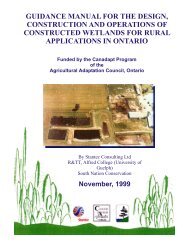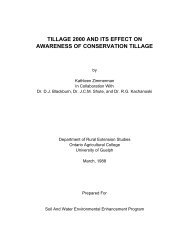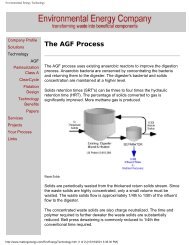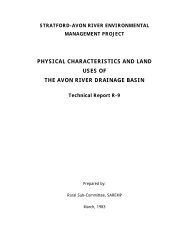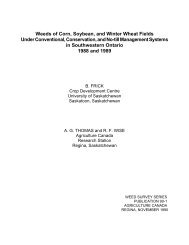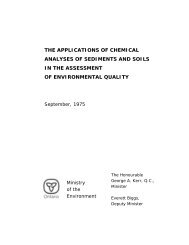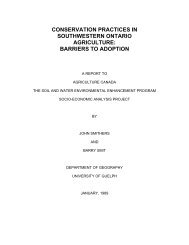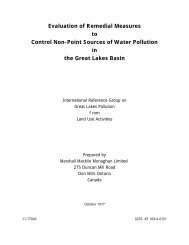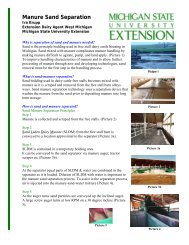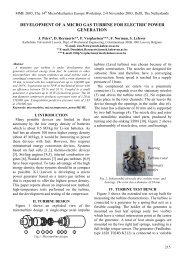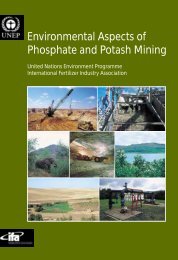evaluation of a mechanical solid-liquid separator for swine manure
evaluation of a mechanical solid-liquid separator for swine manure
evaluation of a mechanical solid-liquid separator for swine manure
Create successful ePaper yourself
Turn your PDF publications into a flip-book with our unique Google optimized e-Paper software.
Solid-Liquid Separation <strong>of</strong> Swine Waste : Final Report3. PROJECT OBJECTIVEThe objective <strong>of</strong> this project was to identify and evaluate a <strong>mechanical</strong> <strong>solid</strong>-<strong>liquid</strong> <strong>separator</strong> thatcould be feasibly be incorporated into a typical Nova Scotia <strong>swine</strong> farming system.The system which was chosen <strong>for</strong> <strong>evaluation</strong> was the TR Separator. The TR <strong>separator</strong> employs acombination <strong>of</strong> scraped inclined screen and screw press separation principles. The TR Separatoris built in Montreal and distributed by Blossum Agritec in North America. A representative fromthe NSDAF and several local hog producers attended the Toronto Farm Show and evaluatedseveral commercially available <strong>swine</strong> waste separation systems. After visiting a hog farm inBritish Columbia that was using a TR <strong>separator</strong> they concluded that the TR <strong>separator</strong> would bethe most promising system to evaluate.4. METHODS4.1. Description <strong>of</strong> the TR SeparatorA schematic diagram <strong>of</strong> the TR <strong>separator</strong> is provided in Figure 1 (Appendix A). Manure is firstpumped into an 8' x 8' x 4' concrete holding tank. A paddle/conveyor system moves the rawwaste onto the inclined screen section. The inclined screen portion <strong>of</strong> the <strong>separator</strong> is 24' longand 2' wide. The screen is divided into three 8' lengths. The bottom section consists <strong>of</strong> a 1.8 mmstainless steel screen. The second 8' screen section has 1.0 mm holes, while the top 8' section is a<strong>solid</strong> piece <strong>of</strong> stainless steel sheet metal. The only function <strong>of</strong> the top section is to add length tothe system enabling <strong>solid</strong>s to be discharged at a higher elevation. This allows <strong>for</strong> thedevelopment <strong>of</strong> higher piles <strong>of</strong> dewatered <strong>manure</strong>. A flight <strong>of</strong> rubber paddles scrapes over thescreen, momentarily removing <strong>solid</strong>s that have and thus allowing <strong>liquid</strong> to sluice through. Thepaddles also act as a conveyor, moving the <strong>solid</strong>s to the top <strong>of</strong> the screen section. At the top <strong>of</strong>the screen section is an 8" screw auger which provides further moisture removal from the <strong>solid</strong>sfraction. A weighted cantilevered door provides pressure to squeeze out <strong>liquid</strong>s. The system iscontrolled by a series <strong>of</strong> electrical floats and switches. Liquids that sluice through the screen areconveyed to a storage lagoon while the <strong>solid</strong>s can be stored on a concrete pad. The makers <strong>of</strong> theTR <strong>separator</strong> claim that the unit can process up to 5000 gpm in flush barns and can produce astackable <strong>solid</strong> product. The unit costs approximately $30,000, not including the additionalexpense <strong>of</strong> housing the system.4.2. Description <strong>of</strong> Farm and Separator Set-upThe TR <strong>separator</strong> system was evaluated on a commercial <strong>swine</strong> farm located in Church Point,NS. The farm is a 600 sow operation and consists <strong>of</strong> three barns which house sows, weaner pigs,and feeder pigs, respectively. Manure slurries are stored in pits below the barns until full. The<strong>liquid</strong> <strong>manure</strong> flows by gravity to a small holding tank (Figure 2 - Appendix A). Be<strong>for</strong>e the-9-
Solid-Liquid Separation <strong>of</strong> Swine Waste : Final Reportinstallation <strong>of</strong> the <strong>separator</strong> the <strong>liquid</strong> <strong>manure</strong> would then be pumped into a three pond lagoonsystem. The TR <strong>separator</strong> was established between the pumping station and 1 st lagoon as shownin Figure 2. The separated <strong>liquid</strong>s flow into the 1 st lagoon through an 8" PVC pipe while the<strong>solid</strong>s are stored on a pad (enclosed by concrete walls on three sides) adjacent to the pumpingstation. Any <strong>liquid</strong>s draining from the <strong>solid</strong> storage pile flow into the 3 rd lagoon. The entirearrangement is enclosed in a heated building. A plat<strong>for</strong>m was also built to allow sampling <strong>of</strong><strong>solid</strong>s discharging from the screw auger. The submersible pump which moves the raw wastefrom the pumping station to the <strong>separator</strong> holding tank is tied into the <strong>separator</strong> control panel.The primary holding tank was originally built 4' deep as specified by the manufacturer.However, it was found that a large portion <strong>of</strong> the <strong>solid</strong>s were accumulating within the holdingtank during initial operations <strong>of</strong> the <strong>separator</strong>. There<strong>for</strong>e mid-way through the project the floor<strong>of</strong> the holding tank was raised to 1' below the elevation <strong>of</strong> the screen. A T-junction was also putin the inflow pipe to aid in distributing the raw <strong>manure</strong> within the <strong>separator</strong> holding tank.Results are presented <strong>for</strong> testing that occurred be<strong>for</strong>e and after these adjustments were made.4.3. Sampling ProtocolLiquid <strong>manure</strong> from the sow, weaner and feeder barns were processed by the TR <strong>separator</strong> inseparate trials. During the operation <strong>of</strong> the <strong>separator</strong>, samples were collected <strong>of</strong> the raw wasteentering the <strong>separator</strong> holding tank, the <strong>liquid</strong> portion draining into the 1 st lagoon, and the <strong>solid</strong>fraction discharging from the screw auger. A 5 L bucket was used to collect a sample <strong>of</strong> the rawwaste each time the pump came on. Each time the pump turned on approximately 2.75 m 3 <strong>of</strong><strong>liquid</strong> <strong>manure</strong> was sent to the <strong>separator</strong>. The volume <strong>of</strong> <strong>liquid</strong> waste processed by the unit wasdetermined by recording the number <strong>of</strong> times the pump came on. Two 500 ml polyethylenebottles were filled each time the raw waste was sampled. Analysis <strong>of</strong> the raw waste included %dry matter, TKN, NH 3 -N, TP, 5-day biochemical oxygen demand (BOD 5 ), TSS, potassium (TK),calcium (Ca), Magnesium (Mg), iron (Fe), Manganese (Mn), zinc (Zn), and copper (Cu).Samples <strong>of</strong> the separated <strong>liquid</strong> fraction were collected every 5 min. Every three samples weremixed to produce one composite sample every 15 mins. Two 500 ml polyethylene bottles werefilled each time the <strong>liquid</strong> fraction was sampled. Analysis <strong>of</strong> the <strong>liquid</strong> fraction included the sameparameters as the raw waste samples. The <strong>liquid</strong> fraction flow rate was recorded using an H-flume. Samples <strong>of</strong> the separated <strong>solid</strong>s were also collected in 5 min time increments andcomposited every 15 mins. Samples were collected in plastic bags and analysis included % drymatter, total N, (TN), TP, TK, Ca, Mg, Fe, Cu, and Zn,. The Carbon:Nitrogen ratio (C:N) <strong>of</strong>each <strong>solid</strong> sample was also determined as the <strong>solid</strong> fraction was to be used as a compost material.All samples were immediately stored in ice-packed coolers and transported to a certifiedanalytical laboratory <strong>for</strong> analysis.-10-
Solid-Liquid Separation <strong>of</strong> Swine Waste : Final Report5. RESULTS AND DISCUSSIONThe ability <strong>of</strong> the TR <strong>separator</strong> to process each <strong>manure</strong> type was evaluated twice, once in 2000and once in 2001. Samples collected in 2000 were taken be<strong>for</strong>e modifications were made to the<strong>separator</strong>. During the 2001 sampling <strong>of</strong> sow <strong>manure</strong>, the <strong>separator</strong> controls appeared to bemalfunctioning, as the pump was erratically turning <strong>of</strong>f and on. Flow in<strong>for</strong>mation was notaccurately obtained, there<strong>for</strong>e only concentration data are reported <strong>for</strong> this trial.Characteristics <strong>of</strong> the raw <strong>manure</strong> and the separated <strong>liquid</strong> fraction are provided in Tables 1 and 2<strong>for</strong> the 2000 and 2001 sampling trials, respectively. The raw <strong>manure</strong> possessed TSconcentrations ranging from 3.4 to 8.1%. On average, the <strong>solid</strong> fraction which was producedrepresented 15% <strong>of</strong> the original volume <strong>of</strong> raw <strong>manure</strong>. Two parameters were calculated togauge the efficiency <strong>of</strong> <strong>separator</strong>; the % reduction in concentration and the % <strong>of</strong> mass removedfrom the <strong>liquid</strong> fraction. Mass removal <strong>of</strong> TS ranged from 13 to 47 %. Mass removals <strong>of</strong> TSwere greatest <strong>for</strong> weaner <strong>manure</strong>. The <strong>separator</strong> consistently removed greater than 20% <strong>of</strong> the TPfrom the <strong>liquid</strong> fraction. The <strong>separator</strong> was least effective in removing TK from the <strong>liquid</strong>fraction which is not surprising as K is usually found in the dissolved <strong>for</strong>m (Bicudo, 2001).Nitrogen mass removal efficiencies ranged from 8 to 28%. These mass removal efficiencies arelower than those reported by Barrington (2000), who also per<strong>for</strong>med an <strong>evaluation</strong> <strong>of</strong> the TR<strong>separator</strong>. During that study 50 to 60% <strong>of</strong> the <strong>manure</strong> <strong>solid</strong>s were removed along with 50% <strong>of</strong>the TN and 35% <strong>of</strong> the TP. However, the <strong>manure</strong> was thoroughly agitated <strong>for</strong> 8 hrs prior to theseparation trial. The mass removal efficiencies achieved by the TR <strong>separator</strong> during this studywere still generally higher than the <strong>mechanical</strong> <strong>separator</strong>s which were reviewed in Section 2.3.The concentrations <strong>of</strong> pollutants remaining in the <strong>liquid</strong> fraction will determine the level <strong>of</strong>treatment/management required after the separation process. The TR <strong>separator</strong> was capable <strong>of</strong>reducing the concentrations <strong>of</strong> all the water quality parameters considering in this study, howeverreductions were low to modest at best. Five-day biochemical oxygen demand and TSSconcentration reductions ranged from -9 to 56% and -11 to 18%, respectively. The negativereductions occurred during the 2000 weaner <strong>manure</strong> sampling trial and are considered suspect.Possible errors could have occurred during sampling or laboratory analysis. Concentrations <strong>of</strong>BOD 5 remaining in the <strong>liquid</strong> fraction were usually greater than 5000 mg/l. Concentrationreductions <strong>of</strong> TN were minimal. Total N concentrations in the <strong>liquid</strong> fraction typically exceeded2000 mg/l and was primarily in the NH 3 -N <strong>for</strong>m.The <strong>liquid</strong> fraction produced from the TR <strong>separator</strong> would require an advanced level <strong>of</strong> treatmentbe<strong>for</strong>e being discharged to the environment. A natural treatment alternative, such as aconstructed wetland or vegetated filter strip, would probably be incapable <strong>of</strong> handling an effluent<strong>of</strong> this nature. Ideally, the <strong>liquid</strong> fraction would be land applied at rates corresponding to cropnutrient requirements.-11-
Solid-Liquid Separation <strong>of</strong> Swine Waste : Final ReportTable 2. Characteristics <strong>of</strong> the raw <strong>manure</strong> and the separated <strong>liquid</strong> fraction <strong>for</strong> 2000 samplingtrials.Manure Type Raw Liquid % ConcentrationReduction% MassRemovalFeederTS (mg/l) 54000 40000 26 29TP (mg/l) 922 736 20 23TN (mg/l) 3448 3177 8 12TK (mg/l) 1477 1534 -4 0.5BOD 5 (mg/l) 13000 7523 42 -TSS (mg/l) 13333 13200 1 -WeanerTS (mg/l) 66000 36000 45 47TP (mg/l) 894 799 11 22TN (mg/l) 2761 2627 5 8TK (mg/l) 1363 1320 3 6BOD 5 (mg/l) 9640 10503 -9 -TSS (mg/l) 4567 5100 -11 -SowTS (mg/l) 34000 26000 24 35TP (mg/l) 837 568 32 43TN (mg/l) 2251 1959 13 26TK (mg/l) 905 847 6 21BOD 5 (mg/l) 10747 4730 56 -TSS (mg/l) 6467 5900 9 --12-
Solid-Liquid Separation <strong>of</strong> Swine Waste : Final ReportTable 3. Characteristics <strong>of</strong> the raw <strong>manure</strong> and the separated <strong>liquid</strong> fraction <strong>for</strong> 2001 samplingtrials.Manure Type Raw Liquid % ConcentrationReduction% MassRemovalFeederWeaner*SowTS (mg/l) 81100 76800 5 13TP (mg/l) 1500 1200 20 22TN (mg/l) 4300 3800 12 18TK (mg/l) 1854 1751 6 13BOD 5 (mg/l) 22620 23737 -5 -TSS (mg/l) - - - -TS (mg/l) 50700 45300 11 28TP (mg/l) 500 400 20 32TN (mg/l) 2000 1800 10 28TK (mg/l) 1058 1004 5 23BOD 5 (mg/l) 3657 3304 10 -TSS (mg/l) 11961 9813 18 -TS (mg/l) 70900 66700 - -TP (mg/l) 300 400 - -TN (mg/l) 1400 1600 - -TK (mg/l) 502 877 - -BOD 5 (mg/l) 5007 4963 - -TSS (mg/l) 6220 8370 - -*Separator controls were malfunctioning-13-
Solid-Liquid Separation <strong>of</strong> Swine Waste : Final ReportIt should also be noted that the pollutant concentration reductions achieved by the TR <strong>separator</strong>are lower than those achieved through conventional lagoon systems. Anaerobic lagoons typicallyachieve TS and BOD 5 reductions <strong>of</strong> 60 and 50%, respectively (Barker, 1996; Chastian et al.1998). Nitrogen reductions in lagoon systems are usually greater as well, however the majority<strong>of</strong> N removal presumably occurs through NH 3 -N volatilization due to anaerobic conditions..The <strong>separator</strong> <strong>manure</strong> processing rates <strong>for</strong> each <strong>of</strong> the trials are presented in Table 4. Themanufacturers <strong>of</strong> the TR Separator claim that the system is capable <strong>of</strong> processing 5000 gpm(1100 m 3 /hr) <strong>of</strong> <strong>liquid</strong> <strong>manure</strong> from a flush system. The highest processing rate observedduring this study was 15 m 3 /hr. Barrington’s study reported that the TR <strong>separator</strong> processed 1.5m 3 <strong>of</strong> <strong>liquid</strong> <strong>swine</strong> waste in 30 mins.Table 4. Manure processing capacity <strong>of</strong> the TR SeparatorProcessing Capacity (m 3 /hr)Manure Type 2000 Sampling Trials 2001 Sampling TrialsFeeder 12.5 8.5Weaner 9 15Sow 15 -The characteristics <strong>of</strong> the separated <strong>solid</strong> fraction are provided in Table 5 and 6 <strong>for</strong> the 2000 and2001 sampling trials, respectively. As stated in Section 2.1, a <strong>solid</strong> dry matter content <strong>of</strong> at least20% is required so that the material can be easily piled and moved with <strong>solid</strong> <strong>manure</strong> handlingequipment. Four <strong>of</strong> the six sampling trials produced <strong>solid</strong>s that had a dry matter content less than20%. It was also visually observed that the <strong>solid</strong> fraction did not stack and that there wassignificant run<strong>of</strong>f from the pile during these sampling trials.The C:N ratio <strong>of</strong> the separated <strong>solid</strong>s ranged from 9.5 to 19. The optimum C:N ratio range <strong>for</strong>composting is 20:1 to 30:1, there<strong>for</strong>e a carbon amendment would have to be added to theseparated <strong>solid</strong>s to facilitate the composting process. Barrington (2000) Found that the TR<strong>separator</strong> was capable <strong>of</strong> producing <strong>solid</strong>s with a dry matter content <strong>of</strong> 15%. The TR <strong>separator</strong>per<strong>for</strong>mance, with respect to producing a relatively dry <strong>solid</strong>s fraction, is less efficient than thetwo commercial screw press <strong>separator</strong>s (Fan Separator, KP Vincent Screw Press) which werereviewed in Section 2.3. One should use caution, however, when comparing <strong>separator</strong>s whichhave been tested under different conditions.-14-
Solid-Liquid Separation <strong>of</strong> Swine Waste : Final ReportTable 5. Characteristics <strong>of</strong> the separated <strong>solid</strong> fraction <strong>for</strong> the 2000 sampling trials.Manure TypeParameter Feeder Weaner Sow% DM (RawManure)% DM (SeparatedSolids)5.4 6.6 3.415.5 22.6 15.9C:N Ratio 13 19 17TP (mg/kg) 1711 1849 2720TN (mg/kg) 4825 4606 6533TK (mg/kg) 1601 1305 1972Table 6. Characteristics <strong>of</strong> the separated <strong>solid</strong> fraction <strong>for</strong> the 2001 sampling trials.Manure TypeParameter Feeder Weaner Sow% DM (RawManure)% DM (SeparatedSolids)8.11 5.07 7.0916.1 16.8 23.1C:N Ratio 9.5 14 17TP (mg/kg) 2500 2000 3200TN (mg/kg) 5400 4300 5000TK (mg/kg) 1748 1040 980-15-
Solid-Liquid Separation <strong>of</strong> Swine Waste : Final ReportThere are several aspects <strong>of</strong> the set-up and operation <strong>of</strong> the TR <strong>separator</strong> that could be adjusted topossibly achieve improved per<strong>for</strong>mance. First, the slurry was not entering the <strong>separator</strong> as ahomogeneous mixture. A basic requirement <strong>for</strong> the efficient separation <strong>of</strong> <strong>swine</strong> <strong>manure</strong> is thecontinuous agitation <strong>of</strong> the effluent that is to be processed (Bicudo, 2001). Otherwise, <strong>solid</strong>swill settle out in the holding tank. The farmer has purchased and recently installed an agitator inthe initial <strong>manure</strong> holding pit. This should help keep <strong>solid</strong>s in suspension while they are beingpumped to the <strong>separator</strong> unit.The manufacturer also states that the TR <strong>separator</strong> is most efficient when processing fresh<strong>manure</strong> (i.e. be<strong>for</strong>e appreciable anaerobic decomposition <strong>of</strong> <strong>manure</strong> <strong>solid</strong>s has occurred).Glerum et al. (1970) state that during the biological degradation <strong>of</strong> pig slurry, the content <strong>of</strong> drymatter usually rises quickly because <strong>of</strong> incomplete decomposition <strong>of</strong> organic matter and thatseparation may be limited when dry matter contents reach greater than 2 to 3%.Barrington (2000) reported that if the screen per<strong>for</strong>ations were reduced to 0.1 mm, as much as80% <strong>of</strong> the TS, 65% <strong>of</strong> the TN could, and 60% <strong>of</strong> the TP could be retained within the <strong>solid</strong>fraction. This in<strong>for</strong>mation was obtained through bench scale experiments, however, and thereport did not include data on the % dry matter <strong>of</strong> the separated <strong>solid</strong> fraction. A smaller screenper<strong>for</strong>ation would probably result in a wetter <strong>solid</strong> fraction.-16-
Solid-Liquid Separation <strong>of</strong> Swine Waste : Final Report6. CONCLUSIONSThe TR <strong>separator</strong> per<strong>for</strong>med well, as compared to results that have been published on theper<strong>for</strong>mance <strong>of</strong> other <strong>mechanical</strong> <strong>solid</strong>-<strong>liquid</strong> separation units. The TR system usuallyremoved greater than 20% <strong>of</strong> the TS and TP from the raw <strong>liquid</strong> <strong>manure</strong>. The <strong>solid</strong>fraction represented approximately 15% <strong>of</strong> the original volume <strong>of</strong> <strong>manure</strong>.The TR <strong>separator</strong> did not produce a <strong>solid</strong> fraction that could be piled. Dry matter contents<strong>of</strong> the separated <strong>solid</strong> fraction were usually below 20%. A dry, carbon based material,such as sawdust or straw, would have to be added to the <strong>solid</strong> fraction to achieve moisturecontents and C:N ratios necessary <strong>for</strong> composting.With respect to decreasing pollutant concentrations within the separated <strong>liquid</strong> fraction,the TR <strong>separator</strong> did not achieve concentrations reductions typical <strong>of</strong> conventional lagoonsystems. The effluent would require significant treatment be<strong>for</strong>e it could be discharged tothe natural environment. A <strong>mechanical</strong> separation system might be more beneficial if thefarmer intended to irrigate the <strong>liquid</strong> fraction onto cropland. Removal <strong>of</strong> the larger <strong>solid</strong>swould enable the farmer to pump and convey the effluent through irrigation equipmentwithout first having to treat it in land-intensive lagoon systems.It is doubtful that the system will result in a significant decrease in odour production asthe majority <strong>of</strong> the odour causing material remained in the <strong>liquid</strong> fraction after theseparation process.Continuous agitation <strong>of</strong> the raw <strong>manure</strong> as it is being pumped to the <strong>separator</strong>, and theuse <strong>of</strong> fresher <strong>manure</strong>, may enhance separation efficiencies.The economic benefit <strong>of</strong> using a <strong>mechanical</strong> <strong>solid</strong>-<strong>liquid</strong> <strong>separator</strong> to process <strong>swine</strong><strong>manure</strong> will largely depend on the potential <strong>for</strong> <strong>solid</strong>s reuse and value recovery.-17-
Solid-Liquid Separation <strong>of</strong> Swine Waste : Final Report7. REFERENCESBarker, J. 1996. Manure <strong>liquid</strong>-<strong>solid</strong>s separation. North Carolina Cooperative ExtensionService. Publiaction No. EBAE 182-93.Barrington, S. 2000. Evaluation <strong>of</strong> TR <strong>separator</strong> and a <strong>manure</strong> slurry aerator. Unpublishedreport.Bicudo, 2001. Frequently asked questions about <strong>solid</strong>-<strong>liquid</strong> separation. University <strong>of</strong> MinnesotaBiosystems and Agrcultural Engineering Extension Program.Http://www.bae.umn.edu/Chastain, J., Lucas., W., Albrecht, J., Pardue, J., Adams., J., and Moore., K. 1998. Solids andnutrient removal from <strong>liquid</strong> <strong>swine</strong> waste using a screw press <strong>separator</strong>. ASAE Paper No.984110. Presented at the ASAE Annual International Meeting. Orlando, Fl. July, 1998.Converse, J., Koegel, R., and Straub, R. 1999. Nutient and <strong>solid</strong>s separation <strong>of</strong> dairy and <strong>swine</strong><strong>manure</strong> using a screw press <strong>separator</strong>. ASAE Paper No. 994050. Presented at the ASAE AnnualInternational Meeting. Toronto, ON. July, 1999.Fernandes, L., McKyes, E., and Obidniak, L. 1988. Per<strong>for</strong>mance <strong>of</strong> a continuous beltmicroscreening unit <strong>for</strong> <strong>solid</strong>-<strong>liquid</strong> separation <strong>of</strong> <strong>swine</strong> waste. 30:151-155.Fleming, R. 1986. Solids-<strong>liquid</strong> separation <strong>of</strong> <strong>manure</strong>. Ontario Ministry <strong>of</strong> Agriculture andFood. Factsheet No. 86-032.Glerum, J., Klomp, G., and Poelma, H. 1971. The separation <strong>of</strong> <strong>solid</strong> and <strong>liquid</strong> parts <strong>of</strong> pigslurry. Livestock Waste Management. 345-347.Moller, H., Lund, I., and Sommer, S. 2000. Solid-<strong>liquid</strong> separation <strong>of</strong> livestock slurry: efficiencyand cost. Bioresour. Technol. 74: 223-229.MWPS (Midwest Plan Service). 1997. Agricultural Waste Management Field Handbook.Ndegwa, P., and Zhu, J., and Luo, A. 2000. Solids-<strong>liquid</strong>s separation <strong>of</strong> <strong>swine</strong> <strong>manure</strong> <strong>for</strong> odourcontrol. ASAE Paper No. 004076. Presented at the ASAE Annual International Meeting.Milwaukee, WI. July, 2000.Pieters, J., Neukermans, G., and Colanbeen, B. 1999. Farm-scale membrane filtration <strong>of</strong> sowslurry. J. Agric. Eng. Res. 73: 403-409.Zhang, R., and Westerman, P. 1997. Solid-<strong>liquid</strong> separation <strong>of</strong> animal <strong>manure</strong> <strong>for</strong> odour controland nutrient management. Appl. Eng. Agric. 13: 657-664.-18-
Solid-Liquid Separation <strong>of</strong> Swine Waste : Final ReportFigure 2. Layout <strong>of</strong> farm and waste management system-20-



